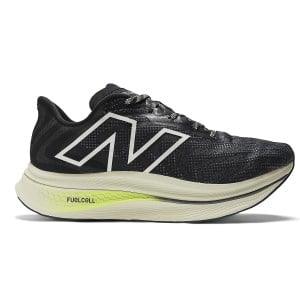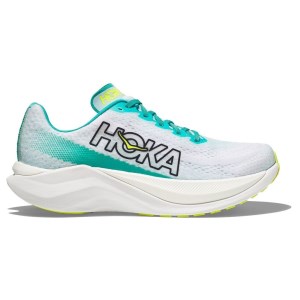Hoka Mach X vs Mach 5 Comparison Running Shoe Review
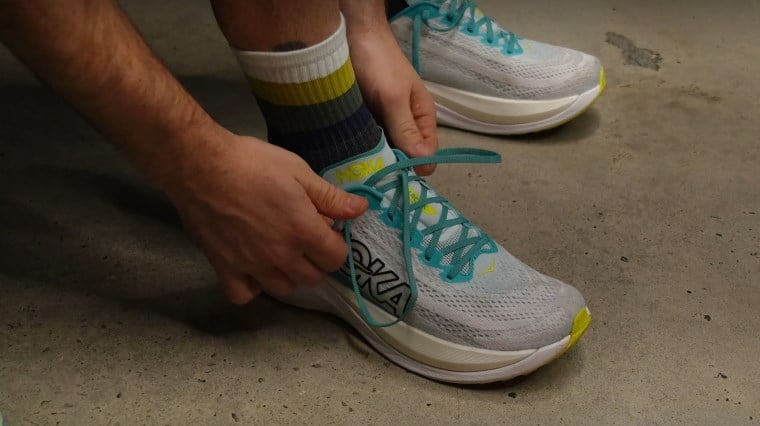
The main difference between the Hoka Mach X running shoes and the Hoka Mach 5 running shoes is the boost in technologies, stack height, durability and responsiveness in the new Hoka Mach X, whereas the Hoka Mach 5 offers a lighter ride that's lower to the ground and offers a more proprioceptive feel.
Running shoe expert Josh Willoughby compares these two versatile 'super trainers' from award-winning brand Hoka. Fantastic for complementing your shoe rotation, they support a variety of running workouts and allow you to push the pace.
The Hoka Mach X wraps your feet with a creel jacquard upper that provides a stronger hold on your feet without compromise to breathability.
Hoka have traded the rubberised EVA outsole of the Hoka Mach 5 for the thin yet more hard-wearing Durabrasion rubber in the Hoka Mach X. This means the Hoka Mach X has more potential as a stand-alone running shoe, whereas the Hoka Mach 5 is best suited as a secondary running shoe in your rotation.
The midsole of the Hoka Mach X running shoes have been loaded with contemporary technologies - the ProFly X midsole, PEBA foam and Pebax propulsion plate for a race-inspired feel at any pace. This combination of technologies creates a balance between plush, shock-absorbing compression and rigid integrity with the full-length Pebax plate to snap into toe-off.
The trade-off for more technology and durability is an increased weight compared to the lighter Hoka Mach 5 running shoes.
However, the Hoka Mach X engineering allows you to gain more speed with less effort. This makes it a game-changing addition to the 'super trainer' category - injecting versatility and extra pace into your daily training.
Check out the review with full transcript below.
Hey guys, Josh here from Sportitude Running. Today I have one of the most exciting shoe reviews I've done in a number of years and I say that because this running shoe is the Hoka Mach X. It's been a shoe that I've used for the best part of 6 weeks and I've used it for a number of different runs.
I've used it for long easy days, I've done tempo runs in it, I've done some gradual pick-me-ups out the door at home and I've really enjoyed what this running shoe is all about and what it represents.
It's extremely exciting and I can’t wait to get into the deep dive details of the Hoka Mach X running shoes. In today's review we’re comparing it to the Hoka Mach 5.
The Hoka Mach 5 running shoe has been a great, reliable shoe for a number of years. Hoka have done some subtle iterations from one season to the next. Actually, they’ve done significant changes to be honest from the first original Hoka Mach franchise to what it is today, the Hoka Mach 5.
The Hoka Mach 5 is still a very exciting running shoe and I like what it represents. It is a really different shoe regarding the output performance of the midsole which is what this review is going to be all about today.
The Hoka Mach 5 and Hoka Mach X are definitely catering to the same person and you can certainly use the Hoka Mach 5 for mileage running. It's a lighter mileage running shoe, so it won't last quite as long as a Hoka Clifton for example but that's OK, that's what you get with a lighter shoe. You can easily put it on your foot and do some tempo runs, intervals and also your progressive runs inside this running shoe.
However, it's all about the midsole today because the performance output between the Hoka Mach 5 and Hoka Mach X is quite different.
In today's review we'll go through the outsole, the midsole, the upper and give you all the nitty-gritty details that you need at home to maybe make one of these your next shoe purchase. Without further ado, let's get stuck in.
Upper
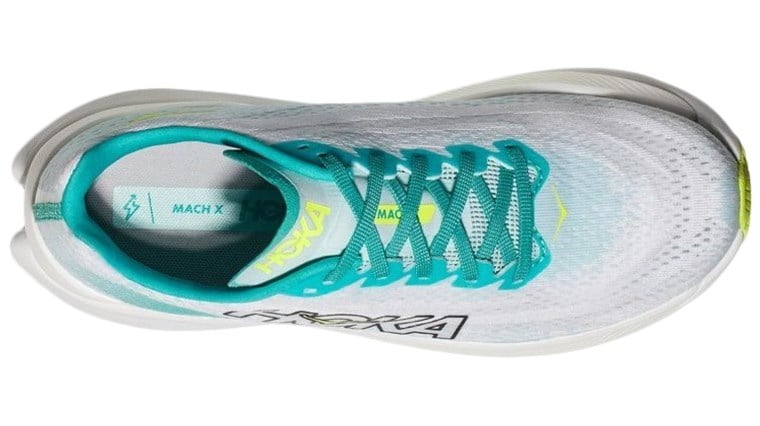
Let's jump straight into the comparison of the Hoka Mach 5 running shoes to the Hoka Mach X running shoes (above). We'll start with the upper first.
With the Hoka Mach 5, Hoka have used an engineered mesh, however it is a recycled mesh. I like when brands use re-purposed materials and find a way to execute them in any part of their shoe and Hoka have done that with the Hoka Mach 5.
We have a pretty similar breathability set-up to what we have with the Hoka Mach X. The Hoka Mach X upper configuration has a creel jacquard mesh. What does that mean and how does it compare with the two side by side?
Technically speaking the creel jacquard mesh will be marginally stronger regarding its overall hold and performance from the first kilometre right through to the last kilometre of this running shoe.
Both of these running shoes use almost identical thickness of tongues and they are very breathable in how they sit on top of your arch. Both have a gusseted construction, so they're designed to keep your foot in position on top of the platform.
The major difference between the two of them is more around the Achilles set-up. With the Hoka Mach 5 we have an Achilles flare and the Hoka Mach X has more of a traditional style heel collar regarding its execution up top.
The internal heel counter is almost identical regarding how high that plastic support system sits. There’s no real benefit between the Hoka Mach X to the Hoka Mach 5 regarding the overall heel cup and fit and feel, you just have the Achilles flare on offer with the Hoka Mach 5.
It's also important to call-out when brands do their running shoes in widths. In the Hoka Mach 5 we have a traditional width with a men's D and a 2E offering. In the women’s model we have a B and a D, so there's two widths on offer with the Hoka Mach 5.
Generally speaking, when a brand launches a new shoe it's very rare they'll make it in two widths because they are testing the market. With the Hoka Mach X we only have a standard width on offer, the men's D and a women’s B.
Outsole
Hoka Mach 5 Running Shoes
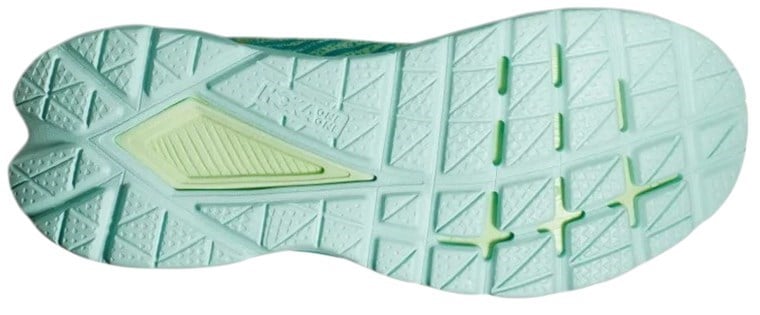
In the Hoka Mach 5 outsole (above), we have the rubberised EVA technology on offer that almost becomes a part of the midsole.
We have two layers of midsole technology, the ProFly+ top layer, and then we have this rubberised EVA bottom layer which then wraps around to become a part of the outsole. Looking underneath the shoe, you can see the exposed ProFly technology with the decoupled design in the back half of the heel unit.
The Hoka Mach 5 running shoe became really durable. I always have a few question marks when brands don't strategically place rubber in high-abrasive wearing areas, but it actually held up pretty well.
I still don't think it's as durable as what Hoka could have made regarding this running shoe, but then again this is not really a shoe that someone is going to do everything in technically speaking.
It’s absolutely fine if you do, but it still is pitched to that person that will have this as potentially the second shoe in their shoe rotation, so it won't be doing all of the running. Therefore, you can reduce the weight a bit by not having a full coverage of rubber placed on the bottom of this running shoe.
Hoka Mach X Running Shoes
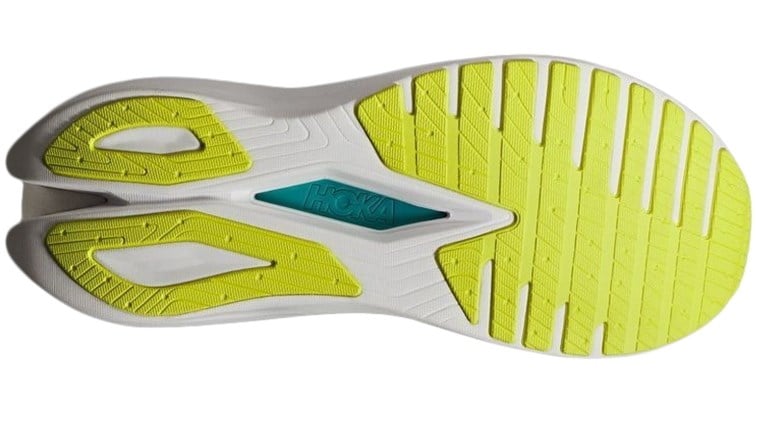
With the Hoka Mach X (above) we need to put a little more time and effort in the outsole. Hoka have used a Durabrasion technology, and that's the same compound in the forefoot as it is in the heel.
It is really thin, so it's not going to be an over-intrusive outsole. It won't add unnecessary weight in areas you don't need it, however it is a very durable rubber.
I've used the Hoka Mach X running shoe for a number of runs here in Adelaide, from wet days to dry days, bitumen to pavement. I've even gone off-road and used it on a gravel surface around a uni loop in Adelaide and it has performed extremely well.
I've really liked what this outsole has done for the overall performance of the Hoka Mach X running shoes.
Midsole
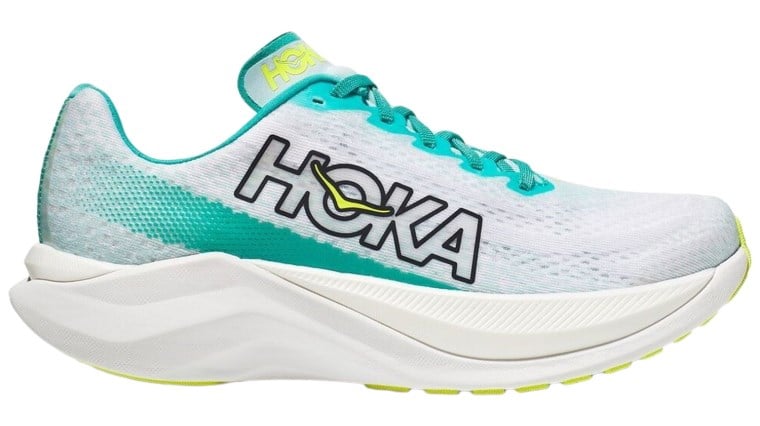
Let's get to the exciting part of today's review and talk all things midsole.
I'll start with the stats of the Hoka Mach X running shoes (above) first. In the men’s model we have a 39mm stack in the heel and a 34mm stack in the forefoot for an offset of 5mm. In the women’s model it is a 37mm heel and 32mm forefoot again for that offset of 5mm.
In comparison to the Hoka Mach 5, it is the same heel-to-toe offset, but we're 10mm closer to the ground. In the men’s model we have a 29mm heel and a 24mm forefoot for that variance of 5mm, and in the women’s model it's a 27mm heel and 22mm forefoot. You still have the same offset but you’re significantly closer to the ground.
Let's talk about the how and the why with regards to both midsoles. The Hoka Mach X has two different midsole technologies on offer. We have a PEBA foam with a ProFly X top layer and that is wedged in with a full-length Pebax plate.
Underneath that Pebax plate, we have Hoka’s EVA foam and it is a little bit firmer than their traditional EVA that we see on the Hoka Clifton and Hoka Bondi for example. The reason it needs to be a little bit firmer is to allow that midsole or that PEBA foam and that Pebax plate to have some structure, integrity and hold to keep your foot on top of this midsole and performing quite well.
I want to call-out a couple of slight technical features. On the lateral side of the Hoka Mach X, EVA foam comes up and almost kisses the lateral side of the heel counter. It drops back down and comes through to the forefoot where it drops off.
On the medial side we don't have any strategically placed arch support or guidance support. It is still targeting a neutral runner, same as the Hoka Mach 5, but the EVA foam comes a little bit closer to the ground underneath your heel, and the PEBA foam sits on top the whole way through on the medial side.
The PEBA foam sits slightly inside that EVA foam, so it does create a bit of a wall. If you have a really responsive foam sitting on top of an EVA foam which is your durable foam in this instance, you're going to get a little bit of instability. Hoka have created a wrap where that EVA foam almost cups the PEBA foam or ProFly X foam to hold it in place so it can perform exactly how it's intended to perform.
The Pebax plate is relatively stiff through the forefoot, and it needs to be because that's exactly what Hoka wanted to achieve with this running shoe.
It needed to be really snappy shoe through toe-off without making it too stiff where you feel like your forefoot is having to work really hard. They've executed that quite well with the ProFly X or that PEBA foam top layer.
Since it is quite thick through the forefoot, you're actually getting a really squishy foam underneath the ball of your foot. Therefore, your forefoot can sink, compress and engage your metatarsal heads to then snap into toe-off. However, it also gives you that rigid integrity with the Pebax plate.
There’s a lot going on with the Hoka Mach X midsole and obviously being 10mm higher, there is a significant performance fit and feel in comparison to the Hoka Mach 5. We have the ProFly+ top layer in the Hoka Mach 5, however it isn't quite as soft and as spongy as what they have executed with the Hoka Mach X. However, that's mainly due to the fact that the Hoka Mach 5 is a slightly lower profile running shoe, being 10mm closer to the ground with that rubberised EVA bottom layer.
What I found with the Hoka Mach 5 running shoe specifically is that it is a shoe that I would like if I wanted more of a proprioceptive feel. If I want to have a connection with the ground or know where my foot placement is every single step, it’s absolutely fantastic.
However, I prefer a running shoe to have more in the midsole so I can actually put some force through that midsole technology and engage that plate to generate propulsion.
The Hoka Mach X running shoe is going to be more responsive. As we touched on in the upper part of this review, Hoka is using a creel jacquard upper that creates a stronger conformed fit up top, because there is going to be more velocity of movement inside the Hoka Mach X.
Your foot will hopefully stay in exactly the position it needs to transition from entry, midstance and release with the Hoka Mach X. It’s still a good durable upper in the Hoka Mach 5, it's just not quite as structurally sound across the saddle part of the fit.
They do target the same runner, someone who wants a versatile running shoe and you can use them both for everything. I know I said in this review that I wouldn't be using the Hoka Mach 5 for everything because it won't wear as long as what a Hoka Clifton would for example. In saying that, I know a lot of people have grabbed the Hoka Mach 5 and use it for everything so it certainly is a great second shoe in your shoe rotation.
If you're looking for that ‘super trainer’ feel, a running shoe that's going to give you that really cushioned, stable but responsive fit underneath the foot, the Hoka Mach X is absolutely one you should be considering.
I found it pretty hard to run slow inside the Hoka Mach X running shoes. Usually when I get a running shoe I like to dial in specifically to what run I'm doing as a part of my training program. However, getting out the door running in the Hoka Mach X, it was very hard to run slow and that is a good thing regarding the overall performance of the midsole. However, it's also a bad thing for those people who wanted to get out the door and just go for an easy day inside the Hoka Mach X.
Perceived effort at pace is significantly less inside the Hoka Mach X in comparison to the Hoka Mach 5 for me personally. That is exactly why I love the Hoka Mach X. It's one of my favourite running shoes of 2023 and I can’t wait to do more kilometres inside this running shoe.
Similar Running Shoes To The Hoka Mach X
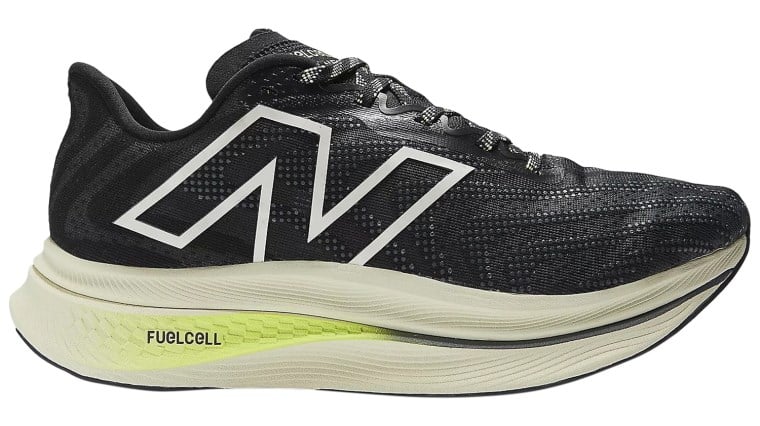
Let's talk about running shoes that are similar to the Hoka Mach X. This ‘super trainer’ category is growing significantly. Brands are putting in a lot of effort to engineering a running shoe that's extremely versatile that could perform literally any single run in someone's training program.
The New Balance FuelCell SuperComp Trainer v2 (above) is certainly one I'd put into the same conversation. The New Balance SuperComp Trainer v1 and the New Balance SuperComp Trainer v2 are significantly different, but I think the New Balance SuperComp Trainer v2 runs very similar to the Hoka Mach X.
You also have your Adidas Boston 12 and the Puma Deviate Nitro 2 as another option to consider. I wouldn't say the Asics Magic Speed would fall into this category, but I would certainly say the Asics SuperBlast while it doesn't have a carbon plate, it is a ‘super trainer’, so it’s also a running shoe that could be used for multiple runs out on the road.
While the ‘super trainer’ category is growing and all brands are putting in running shoes into this specific space to offer that variety of trainers for you the running community, the purpose is the same, but the feel and performance can be slightly different. Keep in mind that while we categorise them as ‘super trainers’, the output will be significantly different from one brand or one shoe to the next.
It's always worth coming into a speciality store like Sportitude Running, having a conversation and going through a shoe selection through the process of elimination to find the one that works best for you.
I can tell you right now, the Hoka Mach X in the 'super trainer' category is the best shoe that works for me. I really like what this running shoe is all about.
Summary
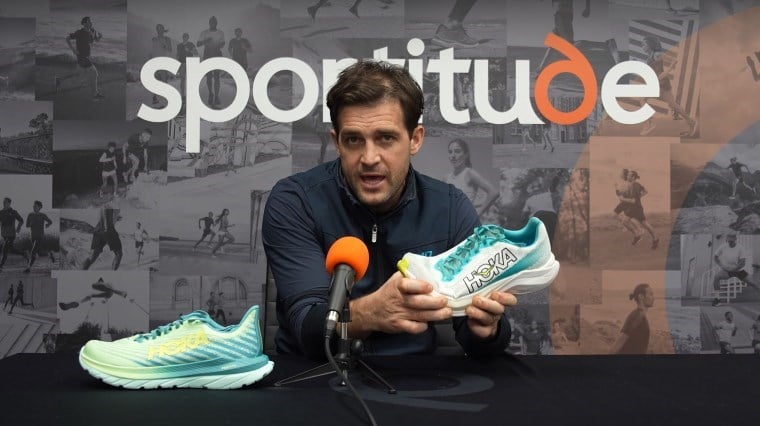
Thank you very much for tuning in to today's comparison review between the Hoka Mach X and Hoka Mach 5 running shoes.
Just a quick summary of what we've gone over, we have a creel jacquard mesh in the Hoka Mach X which is a stronger conformed construction. The Hoka Mach 5 has a 10mm lower stack height compared to the Hoka Mach X but the same heel-to-toe drop.
On the outsole we have rubberised EVA on offer in the Hoka Mach 5 in comparison to your Durabrasion outsole which is what the Hoka Mach X has underneath the foot.
The midsole is pretty much where all the change is. We have two layered technology on offer with the Hoka Mach X. It features the PEBA foam top layer, ProFly X, an EVA bottom layer and full-length Pebax plate.
There is a lot more inside the Hoka Mach X which is probably a great segue to let you know that it is marginally heavier because there is a higher stack and a bit more technology on offer.
The Hoka Mach X is 266 grams for a men's size 9.5 and 227 grams for a women’s size 7.5. In the Hoka Mach 5 we drop down to 230 grams in a men's size 9.5 and 193 grams for women’s size 7.
There’s significant weight variance, but the trade-off here is more durability and a little bit more versatility with regards to overall performance with the Hoka Mach X running shoes.
The Wrap Up
If you have any questions regarding the Hoka Mach X running shoes or the Hoka Mach 5 running shoes please contact our Sportitude shoe experts.
I'd love to know your feedback regarding the 'super trainer' category. If you currently have one in your shoe rotation, please let us know how it's going for you.
We'd love to hear from you the running community all over the world, so thank you so much for tuning in.
Please subscribe to the Sportitude YouTube channel to stay notified and we will keep pumping out shoe reviews like this for you the fantastic running community all over the world.
Until next time, stay safe, be kind to one another, happy running and keep chasing those PBs. We will see you soon, take care.
FEATURES
- Support: Neutral
- Upper: Creel jacquard mesh
- Midsole: Hoka ProFly X
Men
- Weight: 266g / 9.4oz (US 9.5)
- Width: D (standard)
- Heel Height: 39mm
- Forefoot Height: 34mm
- Offset / Drop: 5mm
Women
- Weight: 227g / 8oz (US 7.5)
- Width: B (standard)
- Heel Height: 37mm
- Forefoot Height: 32mm
- Offset / Drop: 5mm
For a more in-depth shoe fitting experience, you can book a free 15 minute video chat in a Live Fit session or make an appointment to discover your RunDNA at Sportitude Running@Hindmarsh.
Book your RunDNA assessment today!
Follow Sportitude Running at:
Instagram: sportitude.running
If you liked this, you'll love:
How To Choose A Carbon Plate Running Shoe
What Type Of Running Shoe Is Best For Me?
Running Shoe Guide 1: What To Do When Your Running Shoes Arrive
Running Shoe Guide 2: How To Break In Your New Running Shoes
Running Shoe Guide 3: How To Clean And Care For Your New Running Shoes

